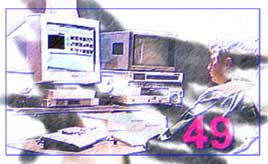|
Module 49 |
Updated: 07/11/2005 |
|
Video Recorder
For the first part of this discussion we'll assume you are using videotape, although, as we've noted, more and more video recorders now use solid-state memory or disks. Video recorders have five basic functions: play, record, stop, rewind, fast-forward, and pause. With the wide acceptance of VHS machines, most people are quite familiar with the basic VCR recorder functions-except possibly how to set the clock! Even so, two things should be mentioned. To record on some machines, the record button has to be held down before pressing the play button. On others, you simply press the record buttons. In either case you will probably see a red light come on, which is the universal standard for the record mode. Since the recording process erases previously recorded material, the tape-if you are using tape-should be checked to make sure there is nothing on it you want to keep. Although the stop mode disengages the tape from the head, the pause button allows the tape to stay in contact with the spinning video heads, ready for an instant start in either the record or playback modes. This can create a problem. If left in pause too long, the video heads will wear
away the recording surface of the tape. This can damage the tape, resulting in video
noise and the dropouts we illustrated at
the end of the last module. To help avoid this problem, most of today's
VCRs will automatically shut down after being left in pause for a few minutes. When the microscopic gap in the video heads of an analog machine is clogged with any kind of matter the result is head clog. At best, a snowy picture will result (photo on right); at worst full-blown snowstorm will take over, and the picture will roll and break up. "Playing" a head cleaning tape for about five seconds may solve the problem. If it doesn't, you may have to get a technician to clean the heads. Some machines have self-cleaning heads, which routinely (and somewhat superficially) clean the heads during normal VCR operations. This will generally take care of minor head clog problems. As we've noted, a few tape machines have confidence heads with the preread function that we previously discussed. They are able to play back the recorded signal a fraction of a second after it has been recorded. Without confidence heads the operator can only monitor the video from the camera. This gives no indication of possible recording problems, which brings us to -
|
|
Spot-Checking a Tape Because dropouts or head clog may not be discovered until the tape is played back, tapes should be spot checked (checked at various spots) after an important recording. Spot checks are done by stopping the tape at the end of the recording, rewinding a meter or two (five or so feet) and checking the last seconds of the tape; then rewinding the tape to about the midpoint and checking again; and, finally, rewinding the tape to the beginning and checking the first five or ten seconds of the recording. Although some people will only check the end of the recording, sometimes head clog problems that develop earlier in a recording will clear up toward the end-a problem you wouldn't know about if you only checked the last few seconds. During spot checks you should check for:
If you do find minor dropout problems and you can't redo the segment, an electronic dropout compensator may be able to unobtrusively fill in missing data as the tape is edited or copied.
Although the following differ between machines-especially between digital and analog machines-the skew control found on some VCR's controls videotape tension. This affects the length of the video tracks as they are "read" (played back) from the videotape. Improper skew adjustment is indicated by flagging, or a bending and wavering of vertical lines at the top of the video frame. Most skew controls have a center "indent" position that indicates a normal setting. Tapes that have been played many times, stretched, or subjected to high temperatures may require a new skew setting. A more common control is the tracking control
that affects the VCR's ability to precisely (and generally automatically)
align the heads with the narrow video tracks recorded on the tape. As with skew,
the tracking control is only used to correct problems during playback. On most videotape formats tracking errors show up in the form of a horizontal band of video noise (shown here). In severe cases there will be a total breakup of the picture. Some VCRs have tracking level meters that represent a readout of the strength of the video signal. If automatic tracking fails or is not present and the video level falls below the optimum level indicated on the meter, the tracking control should be adjusted for maximum signal strength. You may find that a tape has a tracking level that's too low to provide a stable playback. Since VCRs differ, playing the tape on a different machine may help. At least it's worth a try. Packing the Tape Videotape can shed microscopic particles during use. These particles can gradually fill in the gap in the record-playback heads, resulting in head clog and increased head and tape wear. A procedure called packing the tape is often recommended before a videotape is used for the first time. This involves fast-forwarding the tape to the end and then rewinding the tape again to the beginning. It accomplishes two things.
This procedure is also recommended at intervals when the tapes are in long-term storage, which, strangely enough, brings us to....
How permanent is the data recorded on a videotape? We don't know. It hasn't been around long enough, and we haven't stuck to the same tape formats long enough to know if it will last 15 or 50 years. Tests have been run on metal particle tape (used in the D-1 through D-6 formats, plus DVCPRO and DVCAM) to try to determine how stable it is over time. The tape was found to resist electromagnetic loss and damage for at least 15 years if consistently stored at 25°C (77°F) at 50 percent relative humidity. A more practical recommended range for tape storage is a consistent temperature of between 15 and 25°C (59 - 77°F) at a relative humidity between 40 and 60 percent. Fortunately, this ends up being a desirable living environment for both human beings and videotape. However, if the temperature or humidity rise significantly above these levels, damage can occur. Some videotapes have been destroyed in less than one hour when stored at 75°C (180°F). A cassette sitting in the sun in a closed car during the summer can reach that temperature.
Material on videotapes is often intentionally erased or degaussed with a strong magnetic field before use. By using a videotape degausser, you can be sure that the previously recorded material-especially if it has been on the tape for an extended period of time-is entirely erased before the tape is reused. (Over time, the magnetic image on the tape tends to become harder to erase.) At the same time, the information on the tape can be accidentally damaged or destroyed by putting it near a magnetic field. More than one person (including the author) has thoughtlessly laid a video or audio tape down on top of an audio speaker or another piece of equipment, only to find that afterwards the content was unusable.
Finally, we need to mention-and even pay tribute to-a "little black box" that revolutionized videotape recording and made electronic newsgathering possible. Every second a television system must precisely scan more than 15,000 lines for standard NTSC television and more than 35,000 lines for HDTV. Fluctuations in the timing pulses (sync) that control the start and stop points of each of these lines will result in unstable (jumpy) video or serrated (jagged) edges on vertical lines. If things get really bad, there will be a complete loss of video. This timing precision is relatively easy to maintain with purely electronic circuitry. However, once mechanical devices such as tape transport mechanisms are introduced, fluctuations invariably arise. Left uncorrected, these variations create picture instability that gets worse each time the recording-playback process is repeated. You can quickly end up with no picture at all. Until the development of the TBC (time-base corrector), only large, expensive cameras and tape machines could meet broadcast requirements for time-base stability. This meant that there was no such thing as portable broadcast-quality video equipment. The invention of the TBC made it possible to take small cameras and recorders to the scene of news stories and either tape or broadcast the stories "live." Before that, it took several engineers, a few days notice, and an 18-wheeler loaded with equipment to do a major broadcast-which meant there weren't many remote broadcasts.
Although TBCs can be stand-alone (separate) units, today professional
videotape equipment commonly has TBC circuitry built in. |




